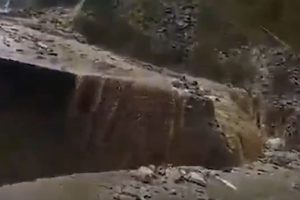Recently I read an amazing historical novel, written in the backdrop of the Turkish invasion in Bengal during the Hindu-Buddhist era. This is a fantastic literary work by Shawkat Ali, one of the most famous novelists in Bangladesh, entitled ‘Prodoshe Prakritojon’ (Oppressed people in the Dusk). This unique novel has been developed by the culture, sadness, love, struggles and emotions of inhabitants in the coastal regions of the rivers Punarbhaba and Aatreyee, in the backdrop of the attack by Bakhtiyar Khilji in 1203-04 A.D. during the reign of Lakshman Sen.
This story of Shawkat Ali revolves around Shyamanga, a potter from the bank of Aatreyee, who takes refuge in a village named Uzubot in the rearward shore of river Punarbhaba, about 45 miles from where Aatreyee meets the river Karatoya. The people of Uzubot are the main characters of this story. The river Punarbhaba in Shawkat Ali’s story is quite a wide river, not at all a miser about her water. This is contrary to the river as it is today. In the story, we find descriptions of large passenger-boats sailing on river. It is also indicated that Aatreyee was even wider.
The story of ‘Prodoshe Prakritajon’ is staged far from the capital city, Lakshmanabati. The social structure was not quite stable and feudal lords were exploiting the common people while the king Lakshman Sen was enjoying the poetry of Umapati, Dhoyi and Jayadeva, sitting on the throne of Lakshmanabati. This novel is an unparalleled documentation of the tragedy of the oppressed in the background of the Turkish attack, in combination with the tradition and the ethnicity of the Bengali people of that era.
Rivers Punarbhaba and Aatreyee today are quite different, they are almost dead. These two are trans-boundary rivers, flowing through India and Bangladesh. There are 52 more such rivers between these two countries. Among these, river Teesta has now become a long-standing issue of intense bitterness among these two neighboring countries. The proper sharing of apparently inadequate water of Teesta is a serious issue, which hits the news time and again and becomes a topic of endless discussion among concerned people.
Recently, Aatreyee and Punarbhaba have also joined in the list of controversial rivers between the two countries. Originating in India and after flowing a long way within Bangladesh, both Aatreyee and Punarbhaba re-enter India. Now, Bangladesh has constructed a concrete dam over the river Aatreyee about 1200 meters from the border and is also regulating the water of Punarbhaba by sluice gates 55 kilometers away from the border.
As a result, people in the river basins depending on these rivers for their livelihood, specially fishermen and farmers, are in great distress, and there is almost no water in vast areas of South Dinajpur. In fact, Aatreyee and Punarbhaba were flowing in the same rhythm even about 800 years ago, Shawkat Ali’s novel will testify to that. Today also they are in tragic condition. And Teesta, Aatreyee and Punarbhaba together are spoiling the relationship between the two Bengals.
In 1972, India and Bangladesh signed a ‘Statute of the Joint River Commission’. There is the provision of Article 253 in the Constitution; however, understandably, the social, political and economic impact of any water-sharing treaty in the catchment area is a very important consideration. Meanwhile, the misery in the catchment areas of Aatreyee and Punarbhaba basin region of West Bengal continues.
Shawkat Ali’s novel depicted the end of an era of Bengal and the oppressed people suffered most in that situation. That’s the ruthless denouement of history; the oppressed people suffer most in any vulnerable period. Similarly, Debesh Roy wrote his novel ‘Teesta Parer Brittanto’ (Story of Teesta Bank) in the backdrop of the construction of the Teesta Barrage. It won the Sahitya Academy Award in 1990.
The common people suffered in the Teesta basin also. At the end of the story, we find that Baghuru Barman and Madari, two important characters of the story, had to find rehabilitation. When a river is about to die, it is nothing but dusk for the common people in the basin, whose livelihoods depend on the river. If this continues, a powerful author will definitely pen another story set in the current period. But, the relief of the common people is possibly much more important than getting another classic like that.
The writer is Professor of Statistics, Indian Statistical Institute.











